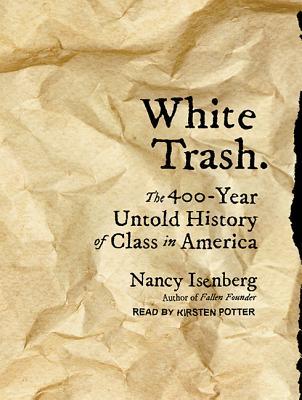
Those seeking a better understanding of the roots of class in the US would do well to seek out Nancy Isenberg’s striking book, White Trash: the 400-Year Untold History of Class in America.
In it, Isenberg shares a perhaps unfamiliar story of the European experience on our shores. Landless people of no means existed before the Revolution and arrived in the first and latter waves of white immigrants.
British vagrants broke the land for their social betters, were pressed into military services as needed, and worked as servants for the Puritan Elect. Orphans scraped off London streets served out indentures in Jamestown. Harsh conditions thinned the numbers of people called waste and rubbish but more arrived on crowded ships.
Property laws, voting restrictions, and land deals conducted amongst the upper classes saw to it that these “tallow-faced clay-eaters” (malnourishment not an evident concern for the well-to-do) rarely joined the ranks of landowners. Those who survived war, workhouses, prostitution, and press gangs ditched their poverty wages and constricted lives and lit out for the territories.
The landed–often speculators who owned from afar–hated these people who were derided as being crackers and squatters. Davy Crockett defended the landless; Andrew Jackson loathed them. However, a few squatters, like Daniel Boone, gained acceptance due to their tracking and hunting skills.
As America’s rulers expanded the nation through purchase, war, and the genocidal destruction of Native tribes, settlers backed by soldiers pushed squatters into less desirable spaces-and so the landless survived as day laborers working alongside slaves, or as precarious tenant farmers, wartime cannon fodder, and sex workers.
Many fled further into the wild, where they served as buffer zones between the forts and official settlers on one side and Native American people who were in the process of being killed or forcibly removed.
It was all too easy for new landowners to lose their standing due to poor crops or when more powerful interests saw easy pickings.
Stereotypes hardened further in slave-holding states. However uneducated, poverty-stunted, vote-denied, and shunned you might be, at least you weren’t a piece of property.
Enslaved people were one potential source of income. A white man who owned even one enslaved Black worker, therefore, was a man with prospects of moving up in the world.
The majority of whites in the slave-holding states, however, owned no slaves. Whether hired to fight in the stead of planters, or whether they enlisted, landless whites joined the Confederate Army in defense of land they didn’t own and an ideology that branded them as a permanent lesser breed.
Southern propagandists described Northerners as being debased by daily labor, no better than slaves, while the aristocracy thought themselves to the manor born.
Union general and later President U.S. Grant insisted that the war in part was fought to free white non-landowners. They, too, needed emancipation from poverty and permanent underclass status.
During the Civil War and decades afterward, with Southern Democrats no longer posing such a huge roadblock, progressives introduced the Homestead Acts (which provided cheap land out West), broadened public education, funded a better-paid permanent military force, did away with most voter/landowner restrictions, and advanced other measures that created a path out of generational poverty.
African-Americans had to battle for even scraps from these initiatives. Native tribespeople were barely considered a footnote.
For whites, however, these efforts, combined with a growing labor movement, gave some a means to escape their class. For others, poverty abided.
In the 20th century, compulsory public education, the GI Bill (free or nearly-free college), powerful trade unions, and the pioneering efforts of the women’s movement gave more hillbillies, crackers, moonshiners, slum rats and hookers-or rather, the humans behind these stereotypes — a means to grow beyond their origins.
They became blue-collar workers, nurses, teachers, carpenters, actors and machinists. They also became voters. They were among the screamers who opposed integration, but they also filled the ranks of the National Guard who enforced the new desegregation laws.
Their grandparents and great-grandparents climbed the economic ladders created by enclave communities of immigrants and government jobs programs. It is possible to credit their hard work, yet also recognize that their racism helped limit access to social uplift programs for African-Americans.
“Hicks”, “trash”, and “dirt” are some of the put-downs applied to today’s erstwhile white squatters. By raw numbers, they make up the majority of social services recipients. They’re poorly educated-yet again and again we see inspiring tales of teachers who uplift entire classrooms into scholarship strivers.
The lowly reside in prisons, wash dishes in diners, or waitress in dives. Doing sex work, working hustles, picking up jobs as day laborers.
For many white people, they are the object lessons in one’s own family-the relatives who for whatever reason remain stuck in reverse.
“White trash” is a term that could be reclaimed as part of our collective American story. The hard labor of poor white people of European descent, combined with that of enslaved Black people, Chinese railroad workers, Mexican farm workers, free African Americans, and many more, built and industrialized the cities, fought the wars, cleared unclaimed lands, and fed and transported people across America.
Although modern politics prefers to focus on culture, religion, and the vanishing middle class, spare a thought for those who dug the ground for Trump Towers and convention centers.
The lowly live among us, ill-considered, too often actually ill. That some bring hardships upon themselves doesn’t change the cruel math for their children or alter the fact that our lower ranks can rise up-or fall back-in a generation.
White Trash is a memorable read by Isenberg. The book is currently available in hardcover, so ask for it at your public library.







